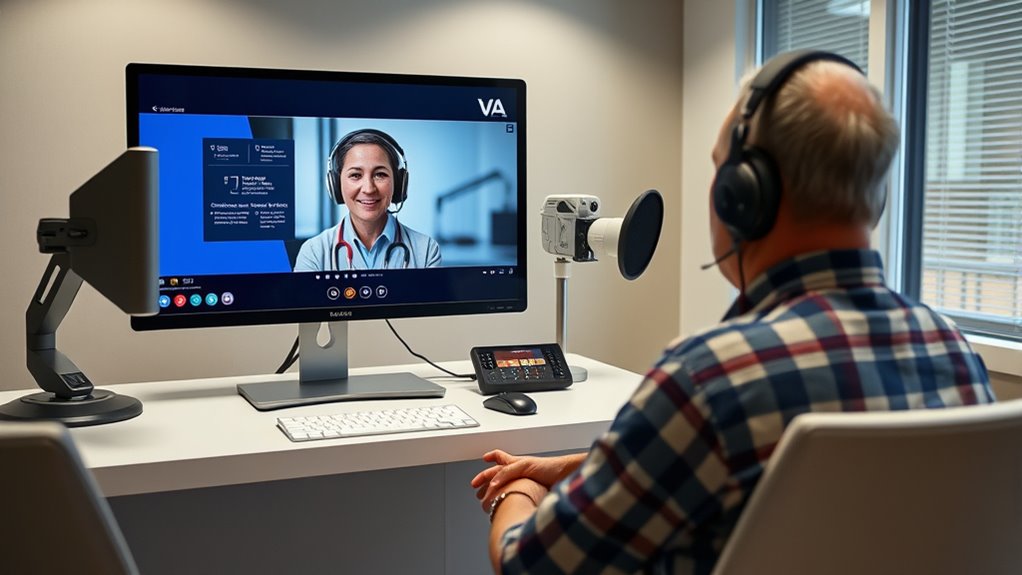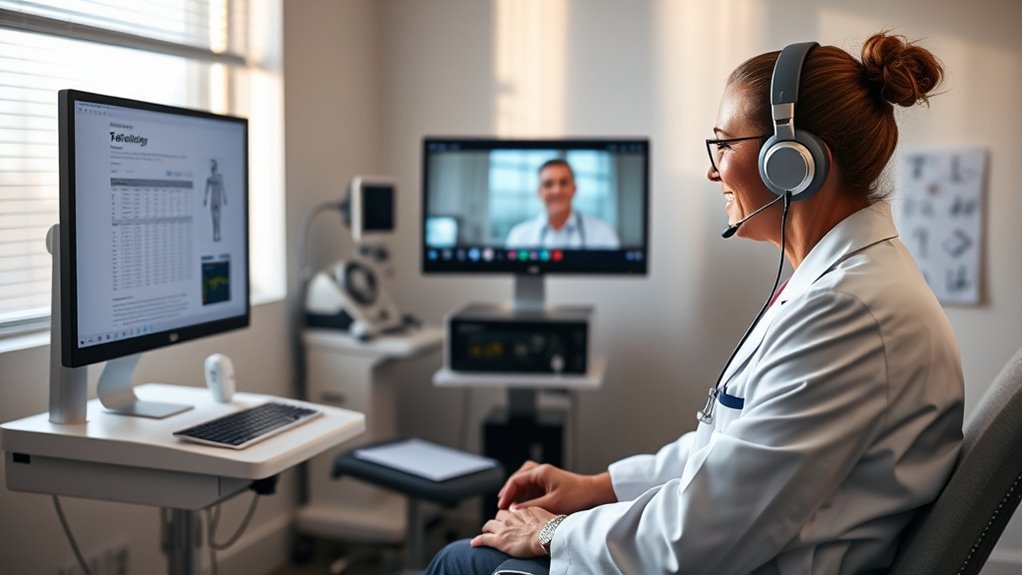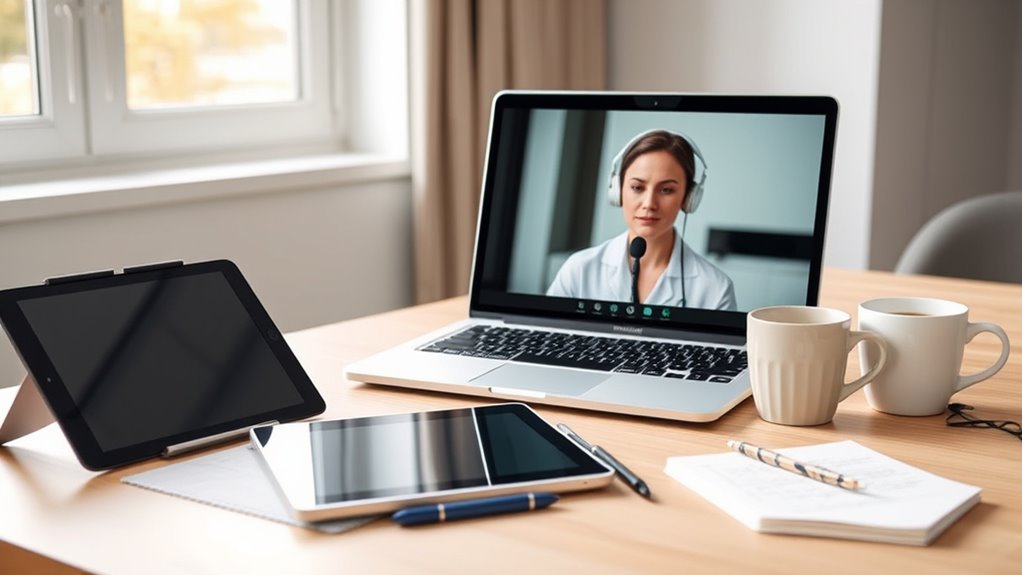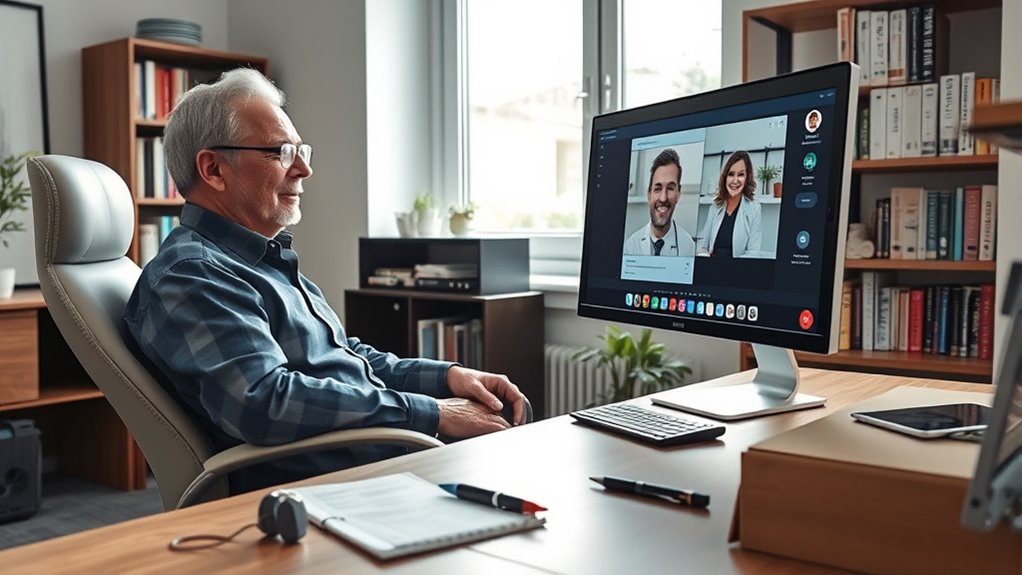To get VA tele-audiology services approved, guarantee you’re enrolled in VA healthcare and have proper documentation of your hearing loss or related conditions. Contact your VA provider to confirm your eligibility, gather necessary medical records, and verify facility-specific requirements. Prepare for technical setup by testing your internet and devices in advance. Staying updated on VA policies and maintaining clear communication with your healthcare team helps smooth the approval process—continue exploring for more helpful tips.
Key Takeaways
- Verify eligibility with proper documentation, including VA enrollment, service-connected disability, or medical records.
- Understand specific VA facility requirements and guidelines for tele-audiology approval processes.
- Prepare detailed plans demonstrating how remote care aligns with VA policies and patient needs.
- Train staff on tele-audiology procedures, hearing aid maintenance, and secure data handling practices.
- Communicate the benefits of remote services to administrators and stay updated through VA policies and webinars.
Understanding VA Tele-Audiology Services

VA Tele-Audiology services allow you to receive hearing care and audiology evaluations remotely, making it easier to access expert care from the comfort of your home or local facility. With these services, you can consult with an audiology technician who guides you through hearing assessments and troubleshooting. If you wear hearing aids, tele-audiology also covers hearing aid maintenance, helping you with cleaning, adjustments, and troubleshooting without visiting a clinic in person. The audiology technician uses remote technology to ensure your devices are functioning properly and provides guidance on proper care. This approach saves you time and travel, giving you convenient access to high-quality audiology services and support, all tailored to meet your individual hearing needs. High-quality audiology services are essential for maintaining effective hearing health care.
Eligibility Criteria for Remote Hearing Care

To access VA tele-audiology services, you need to meet specific eligibility requirements. You’ll be asked to provide documentation that verifies your condition and confirms your eligibility. Ensuring your information is accurate and complete helps streamline the process and gets you the care you need faster. Additionally, understanding the criteria for remote hearing care can help you better prepare for the application process.
Service Eligibility Requirements
Are you wondering if you qualify for VA tele-audiology services? To be eligible, you need to meet certain service criteria. Your VA disability rating must typically include hearing loss or a related condition, and you should already be enrolled in VA health care. Insurance coverage can influence your eligibility, especially if private insurance is involved, but VA benefits often take precedence. Additionally, provider qualifications matter; the VA ensures that tele-audiology services are delivered by trained, credentialed audiologists who meet strict standards. If you meet these basic requirements, you can access remote hearing care. Keep in mind that specific eligibility may vary based on your individual circumstances and VA policies. Understanding audiology concepts can help you better navigate your options for remote hearing services.
Documentation and Verification
Wondering what documentation you need to access VA tele-audiology services? You must verify your eligibility with proper documentation and guarantee your provider meets qualifications. The VA reviews your medical records and service history to confirm your status. Accurate documentation streamlines billing procedures and prevents delays. Ensuring your eligibility criteria are met helps facilitate a smooth process. Providing complete, verified documentation helps avoid billing issues and guarantees your provider is qualified to deliver remote hearing care. Keep your records updated and accessible to facilitate a smooth tele-audiology experience.
Steps to Initiate Tele-Audiology Appointments

Initiating a tele-audiology appointment involves several essential steps to guarantee a smooth experience. First, contact your audiology clinic to schedule your session and confirm technical requirements. Make sure your hearing aids are functioning properly and charged, as they might be tested or adjusted remotely. Before the appointment, test your internet connection and ensure your device has a camera and microphone working correctly. Gather any relevant medical history or previous hearing assessments to share with your audiologist. Follow the clinic’s instructions for setting up your space, choosing a quiet environment, and positioning your device. Additionally, check for properly functioning hearing aids to ensure optimal remote testing and adjustments. By preparing in advance, you help ensure the appointment runs smoothly and that you receive the best possible remote care.
Documentation Needed for Approval

To get your tele-audiology appointment approved, you’ll need to gather specific documentation to verify your eligibility. Start by reviewing your medical records to confirm your hearing loss diagnosis and current treatment history. You may also need to provide proof of VA enrollment or service-connected disability status. This documentation helps with medical record reviews, making sure your condition qualifies for VA tele-audiology services. Additionally, familiarize yourself with insurance claim procedures, as you might need to submit insurance information or authorization forms. Having these documents ready streamlines the approval process and minimizes delays. Ensure your records are current and complete, so your provider can quickly verify your eligibility and move forward with scheduling your remote care. Understanding the types of hearing loss involved can also assist in providing accurate information during your application process.
Common Challenges and How to Overcome Them

Many patients face challenges with tele-audiology, such as technical issues, connectivity problems, or unfamiliarity with remote technology. Technology barriers can make it difficult to access or use the necessary equipment, but these can often be addressed with simple troubleshooting or guidance. Ensuring a stable internet connection and testing devices beforehand helps reduce disruptions. Another common challenge is provider availability; clinics may have limited appointment slots or long wait times. To overcome this, plan ahead by scheduling appointments early and confirming provider hours. Support from technical staff or caregiver assistance can also ease the process. Staying informed about available resources and proactively addressing potential hurdles helps you get the most out of your tele-audiology experience. Additionally, understanding air quality factors and how they impact health can be beneficial when considering remote care options.
Communicating With Your Healthcare Team

Effective communication with your healthcare team is key to getting the best care. Sharing detailed symptom information helps your providers understand your needs better. Using clear, straightforward language guarantees your concerns are accurately addressed. Incorporating specific dog names can help personalize your interactions and make your communication more engaging.
Clear Communication Strategies
Clear communication is essential when working with your healthcare team to guarantee your hearing health needs are understood and addressed. To advocate effectively for yourself, be clear about your concerns and ask questions when anything isn’t clear. Always confirm appointment details and scheduling to avoid misunderstandings or missed visits. Keep a list of symptoms and questions ready before your tele-audiology sessions, so you can share accurate information. If you encounter technical issues, inform your team promptly to ensure timely resolution. Active listening helps you understand your provider’s instructions and advice. Remember, patient advocacy means speaking up for your needs and ensuring your voice is heard during every step of your hearing care journey. Clear, direct communication makes remote care more effective. Incorporating effective communication strategies such as confirming details and asking questions can significantly improve your tele-audiology experience.
Sharing Symptom Details
How can you guarantee your healthcare team understands your hearing issues accurately? The key is providing clear, detailed symptom descriptions. Use specific communication techniques, such as noting when your hearing worsens or identifying particular situations that challenge you. Describe how sounds seem muffled or distorted, and mention if certain environments, like crowded rooms, make things worse. Be honest about your experiences, and avoid vague statements like “I don’t hear well.” Writing down your symptoms beforehand can help ascertain you don’t forget important details. During your tele-audiology appointment, speak openly and use these communication techniques to convey your symptoms clearly. Effective communication is essential for ensuring your healthcare team can accurately assess your condition. Accurate symptom descriptions enable your healthcare team to diagnose effectively and recommend the best treatment options.
The Role of Technology in Successful Remote Care

Technology plays a essential role in enabling successful remote audiology care by providing reliable tools for assessment, diagnosis, and treatment. With advanced telehealth platforms, you can connect with patients through high-quality video and audio, guaranteeing clear communication. Assistive devices, such as remote hearing aids and mobile apps, enhance patient engagement by allowing real-time adjustments and monitoring. These tools help you gather accurate data and deliver personalized care without the need for in-person visits. Reliable technology also minimizes disruptions, making sessions more effective and comfortable for both you and your patients. Ultimately, the right technological solutions foster trust, improve outcomes, and ensure that patients receive all-encompassing care regardless of their location.
Tips for a Smooth Approval Process

To guarantee a smooth approval process for tele-audiology services, start by thoroughly understanding your facility’s specific requirements and guidelines. Clear documentation helps streamline approval. Next, ensure your staff is trained on hearing aid maintenance protocols and appointment scheduling procedures, so they can address patient concerns efficiently.
Here are four tips to keep the process seamless:
- Prepare detailed plans that align with VA policies.
- Include evidence of secure data handling for remote care.
- Communicate clearly with administrators about tele-audiology benefits.
- Gather all necessary documentation, including proof of staff training.
Staying Informed About Policy Updates

Staying informed about policy updates is essential to guarantee your tele-audiology services remain compliant and effective. Policy changes can impact coverage, documentation, and telehealth procedures. To stay ahead, regularly review updates from VA and federal agencies, and participate in advocacy efforts to shape future policies. Being proactive ensures you adapt quickly and maintain seamless patient care. Here’s a quick reference:
| Policy Area | Recent Changes | How to Stay Updated |
|---|---|---|
| Telehealth Regulations | Expanded coverage for remote care | Subscribe to VA alerts |
| Privacy & Security | New data protection rules | Join advocacy groups |
| Reimbursement Policies | Adjusted billing codes | Attend VA webinars |
| Licensing & Credentialing | Cross-state practice updates | Follow official VA communications |
Frequently Asked Questions
How Long Does It Typically Take to Get Tele-Audiology Approval?
Getting tele-audiology approval usually takes a few days to a week, depending on your insurance approval process. You should expect the appointment timeline to be affected by how quickly your insurance reviews and approves the request. To speed things up, make sure all necessary documentation is submitted promptly. Once approved, you can schedule your remote care appointment without much delay, fitting it into your preferred timeframe.
Are There Specific Devices Recommended for Remote Hearing Assessments?
You might think any device works for remote hearing assessments, but surprise—device compatibility actually matters. For accurate results, use recommended devices that guarantee clear audio and proper connection. While hearing aid options vary, choosing compatible tech is vital for seamless tele-audiology sessions. Don’t settle for just any device; the right one guarantees better assessments, making your remote care more effective and less frustrating.
Can Family Members Assist During Tele-Audiology Sessions?
Family involvement and caregiver assistance can be helpful during tele-audiology sessions. You might find it beneficial to have a family member or caregiver present to help set up equipment, ensure clear communication, and provide emotional support. Their assistance can make the process smoother, especially if you need help following instructions or managing technical aspects. Just confirm with your audiologist if their presence is appropriate for your specific session.
What if I Experience Technical Issues During My Appointment?
Did you know that about 20% of telehealth sessions face technical issues? If you experience trouble during your appointment, don’t worry—troubleshooting issues is common. Reach out to technical support immediately for guidance. They’re trained to help you quickly resolve problems, ensuring your appointment continues smoothly. Stay patient and follow their instructions to minimize disruptions, and your remote care will stay on track.
Are There Differences in Care Quality Between In-Person and Remote Services?
You may wonder if care quality differs between in-person and remote services. Rest assured, tele-audiology uses advanced technology effectiveness to provide high-quality care comparable to in-person visits. The VA ensures remote care maintains strict standards, so your hearing health receives the same attention. With proper setup and support, you get effective, convenient care from the comfort of your home, without sacrificing quality or personalized attention.
Conclusion
Think of VA tele-audiology as a bridge connecting you to care, no matter the distance. With the right steps and clear communication, you can cross smoothly into remote hearing support. Just like a sturdy bridge withstands storms, staying informed and prepared keeps your journey steady. Embrace technology as your trusted pathway, ensuring your hearing health remains strong and connected—no matter where you are.











